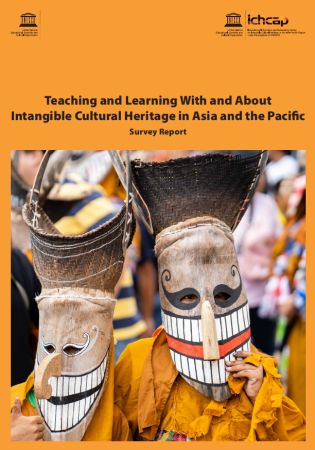ACTIONS
- Protect and safeguard cultural and natural heritage
- Learning and educational opportunities
- Cultural participation/social inclusion
- Sustainable tourism
- Support research
- Employment (recruiting, training, safety)
- Energy consumption, greenhouse gas emissions
- Waste management and reduction
- Transport (forms of, energy use)
- Commercial activities including copyright and IP
- Governance and management
- Security, disaster preparedness, risk reduction
- External partnerships and collaborations
- Publication/report
Teaching and Learning With and About Intangible Cultural Heritage in Asia and the Pacific Survey Report

Intended Audience
Educators, teachers, school managers, but also suitable for ICH knowledge holders, heritage and cultural practitioners, members of communities, officers and lawmakers responsible for cultural affairs and education
- UNESCO, International Information and Networking Centre for Intangible Cultural Heritage in the Asia and the Pacific Region (ICHCAP)
The resource “presents the findings of a recent survey targeting teachers and school managers in the Asia-Pacific region. It provides a broad overview of how ICH is currently being used in schools in the region, and identifies needs for future interventions and support.”
Avaiable in
- English
SDGs LINKAGES
This report is comprehensive in providing recent information and recommendations related to teaching and learning of intangible cultural heritage (ICH) in different countries in Asia and the Pacific. It is with an emphasis on ICH’s significance in contributing towards SDG 4 (quality education). This resource in general addresses SDG targets 4.1 (quality primary education), 4.5 (eliminate gender disparities through teaching), 4.7 (education for sustainable development and appreciation of cultural diversity), 11.4 (safeguard world’s intangible cultural heritage), 11.A (strengthen links between the urban and rural areas through ICH teaching and knowledge transfer), 16.7 (participatory and inclusive decision-making), 17.14 (incorporate ICH into education policies and curricula), 17.17 (encourage effective civil society partnerships).
Click on the SDG Target to discover Our Collections Matter indicators
-
Our Collections Matter indicators:
- Number of programmes drawing on collections that support children at risk of exclusion or otherwise not completing primary and secondary education.
-
Our Collections Matter indicators:
- Number of educational and/or training programmes drawing on collections directed to eliminate gender disparities in education.
- Number of educational and/or training programmes drawing on collections directed to meet the particular needs of persons with disabilities.
- Number of educational and/or training programmes drawing on collections directed to meet the particular needs of Indigenous peoples’ groups.
- Number of educational and/or training programmes drawing on collections directed to meet the particular needs of children in vulnerable situations.
-
Our Collections Matter indicators:
- Numbers of people in each type of programme drawing on collections from different demographic groups.
- Increases in numbers of people in each type of programme from different demographic groups.
- Proportion of people involved in such programmes in relation to overall audience size.
- Evidence that learners have acquired knowledge and skills to promote sustainable development.
-
Our Collections Matter indicators:
- Total expenditure (public and private) per capita spent on the preservation, protection and conservation of all cultural and natural heritage, by type of heritage.
- Plans, policies and procedures in place for the safe use of collections for a variety of purposes, protecting and safeguarding both collections and those who use them.
- Plans, policies and procedures in place for the identification, safeguarding and protection of cultural and natural heritage at risk.
- Collecting programmes in place to protect, safeguard and make use of cultural and natural heritage, addressing the needs of communities and stakeholders, and ensuring that collections can be an effective resource for sustainable development.
- Number and diversity of educational, awareness-raising, research programmes, and partnerships that aim to strengthen protection of cultural and natural heritage.
-
Our Collections Matter indicators:
- Considerations of regional economic, social and environmental trends and risks incorporated into collecting institutions’ planning.
- Participation in local and regional planning, to foster access to services, cultural participation, prevent exclusion, and support equitable urbanisation.
- Ensure data collection and metrics can be useful for planning in conjunction with other sectors and between urban and rural areas.
- Number of outreach and other activities that promote awareness and accessibility of collecting institutions in urban and rural areas, and that promote awareness of regional development plans and risks, with opportunities for people and communities to input into such plans.
-
Our Collections Matter indicators:
- Proportions of positions (by sex, age, persons with disabilities and population groups) in public institutions (national and local legislatures, public service, and judiciary) compared to national distributions.
- Proportion of population [audience/users/non-users] who believe decision-making is inclusive and responsive, by sex, age, disability and population group.
- Decision-making addresses societal, environmental and economic challenges related to the community, considering short-term and long-term risks and opportunities.
- Decision-making draws on diverse backgrounds, viewpoints and interests, reflecting a broad base of stakeholders, and working to promote inclusion and provide effective services for all of society.
-
Our Collections Matter indicators:
- Proportion of policies that incorporate sustainable development considerations, linking to SDGs and targets.
- Incorporation of policy considerations from outside the collections sector into policies of collections-based institutions, to facilitate partnerships and effectiveness.
-
Our Collections Matter indicators:
- Amount of United States dollars committed to public-private and civil society partnerships.
- Number and/or increase in number, and diversity of local, national and regional multi-stakeholder (public, public-private and civil society) partnerships that address the SDGs drawing on collections, or that otherwise involve collections-based organisations and institutions.
